Auto retails register strong double-digit gains in July, PV inventory jumps to Rs 73,000 crore
After the flat sales in June, the 2 million units in July are an increase of 14% YoY with the two-wheeler, three-wheeler, car and SUV, and commercial vehicle segments registering strong sales. Passenger vehicle inventory though remains a worry – the highest-ever at 67-72 days, equating to Rs 73,000 crore worth of stock.
Despite an inclement monsoon season which has impacted different parts of the country, India’s automobile retail sector has registered strong double-digit year-on-year growth of 14% to cross the 2-million-units mark in July 2024. The month-on-month increase too, at 7.31% over June 2024’s 1.89 million units and flat sales, augurs well for India Auto Inc retail growth.
Of the five segments, all but tractors witnessed demand growing YoY. Two-wheelers, the biggest volume segment, clocked sales of 1.44 million units, up 17% YoY and 5% MoM. The passenger vehicle segment, with 320,129 units was up 10% YoY and 13.70% MoM, albeit continues to see very high inventory levels (more on that in the PV section below). Three-wheeler demand, at 110,497 units, was 13% YoY and 17% MoM. Commercial vehicles, at 80,057 units, was up 6% YoY and 10% MoM. Tractors, reflecting the continuing slowdown due to weather conditions, was down 12% YoY albeit up 12.59% MoM. Let’s take a closer look at each vehicle segment.
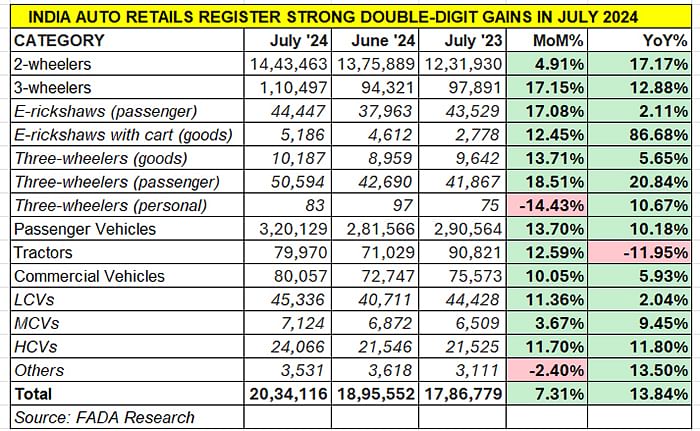
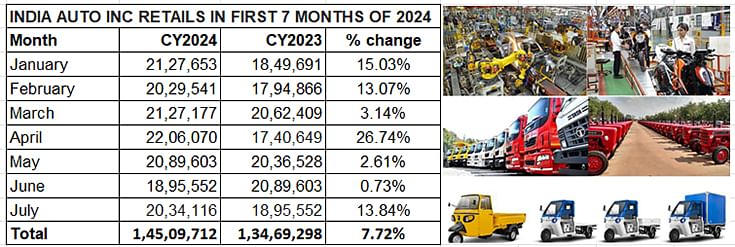
2-WHEELERS: 1.44 million units, up 17% YoY, 5% MoM
Hero MotoCorp sells 370,204 units, 30,571 more than Honda
When a sector sells an additional 211,533 units in a month or 6,823 units every day, it is a clear indication that it is on a strong footing. In July 2023, Indian scooter and motorcycle manufacturers sold a total of 14,43,463 units, up by a 17% YoY (July 2023: 13,75,889).
FADA attributes the strong growth to thriving rural economy, positive impact of the monsoon in this segment, and government support programs enhancing rural incomes. What has also helped is the rollout of new products and better stock availability, despite market slowdowns in certain regions, excessive rains, and increased competition. The segment also saw an increase in EV sales due to discounts and buyers rushing to buy zero-emission scooters and bikes before the now-extended EMPS scheme’s original deadline of July 31.
July saw most manufacturers, across segments, rationalise their inventory levels. Hero MotoCorp, which dispatched 370,204 units to showrooms compared to Honda Motorcycle & Scooter India’s 439,118 units, maintains its No. 1 status on the retail front – Hero sold 399,324 units, 30,571 more two-wheelers than HMSI, which gives it a market share of 27.66% vs HMSI’s 25.55%. Nevertheless, the fact remains that Honda is hard on Hero’s heels.
TVS Motor Co, the No. 3 OEM, sold 251,140 units, which gives it a market share of 17.40% and similar to what it had a year ago. TVS sold 19,471 iQubes last month, which gives it an EV penetration level of 7.75% and an 18% share of India’s e-two-wheeler market.
Bajaj Auto, with 161,435 units, is ranked fourth and has a July 2024 market share of 11%, down from 12% a year ago. The company, which is seeing strong demand for its Chetak EV, sold 17,642 units of the e-scooter and sees an EV penetration level of 11 percent.
While Suzuki Motorcycle India's market share increased marginally to 5.53%, Royal Enfield, with 57,325 bikes, saw its share reduce to 4% from 4.57% in July 2023. 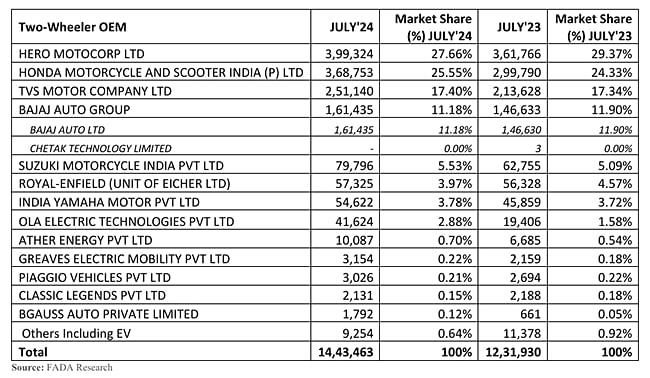
3-WHEELERS: 110,497 units, up 13% YoY, 17% MoM
Best-ever electric 3W retails power overall 3W industry sales
The three-wheeler segment, with 110,497 units, registered 13% YoY growth and 17% MoM growth. This is thanks to the segment hitting its best-ever electric 3W monthly retail sales of over 63,000 units in July 2024, which thereby contributed to 57% of overall three-wheeler industry sales last month.
July 2024 sales of 110,497 units are the highest in the first seven months of the current year – January (97,675), February: 94,918), March (105,222), Aprl (80,105), May (98,265) and June (94,321). Bajaj Auto, with 38,728 units sold in July, retains its stranglehold on the 3W market with a 35% share. The company, which entered the electric 3W market only 14 months ago is now ranked third on the EV ladder-board.
Piaggio Vehicles, with 8,439 units sold in July and comprising a mix of diesel, CNG and electric powertrains, has a share of 7.64%, slightly down from the 8.12% it had a year ago.
Mahindra Last Mile Mobility, the leader in the e-3W market, sold a total of 7,650 units (across powertrains to take third place and a market share of 7 percent.
The fastest transition to e-mobility is being witnessed in this segment, which has over 500 players all vying for a slice of the action. Here’s a quick look at the Top 30 electric three-wheeler OEMs in July 2024.
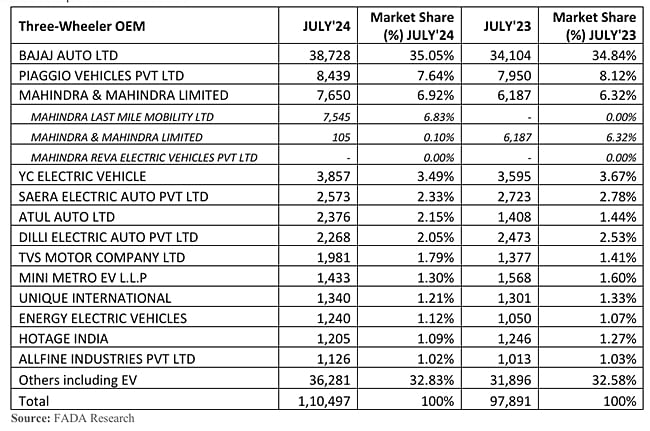
PASSENGER VEHICLES: 320,129 units, up 10% YoY, 13.7% MoM
Maruti Suzuki share at 40%, Tata Motors pips Hyundai to No. 2 rank, strong gains for M&M
PV inventory at its highest level of 67-72 days equating to Rs 73,000 crore of stock
Passenger vehicle retail sales saw a robust growth last month, driven by new model launches and attractive pricing strategies. Dealers reported benefits from good product availability, attractive schemes, and a wider range of products. Nonetheless, heavy rains, low consumer sentiment, and intense competition posed challenges. Some dealers managed to sustain sales through strong promotions and incremental discounts, says FADA.
However, FADA has once again raised the red flag of high inventory levels in the PV segment. According to FADA vice-president C S Vigneshwar, “This growth (in July) is accompanied by a significant concern – inventory levels have surged to a historic high of 67-72 days (up from 62-67 days in June 2024), equating to Rs 73,000 crore worth of stock. This poses a substantial risk for dealer sustainability, necessitating extreme caution. FADA urges PV OEMs to be vigilant about potential dealer failures due to these high inventory levels. It is also crucial for the Reserve Bank of India to mandate financial institutions to implement stringent checks before releasing inventory funding, preferably requiring dealer consent or collaterals to prevent the escalation of NPAs.”
Market leader Maruti Suzuki holds its sway with 129,177 units for a market share of 40.35%, slightly below its year-ago share of 41 percent. Tata Motors, whose wholesales were down 6% to 44,725 units last month and behind Hyundai, has pipped Hyundai Motor India on the retail sales front. Tata sold 43,422 222 cars and SUVs more than Hyundai to take a 13.56% PV market share, ahead of Hyundai’s 13.43%, albeit both OEMs’ July 2024 share is down on their July 2023 share.
Mahindra & Mahindra, which continues to capitalise on the SUV boom, sold 37,854 units – a performance which sees its market share rise to 12% from 10% in July 2023. Meanwhile, Toyota Kirloskar Motor, which is witnessing a strong run of demand for its portfolio of cars, SUVs and MPVs, sold with 21,182 units to see its PV share increase to 6.62 percent. Kia India, with 18,682 units, has also gained in market share, which is 6.62% from 5.57% a year ago.
These six PV OEMs combined account for 293,317 units and 91.62% share of the market, leaving less than 9% to the other players fighting for a slice of one of the fastest growing auto markets in the world.
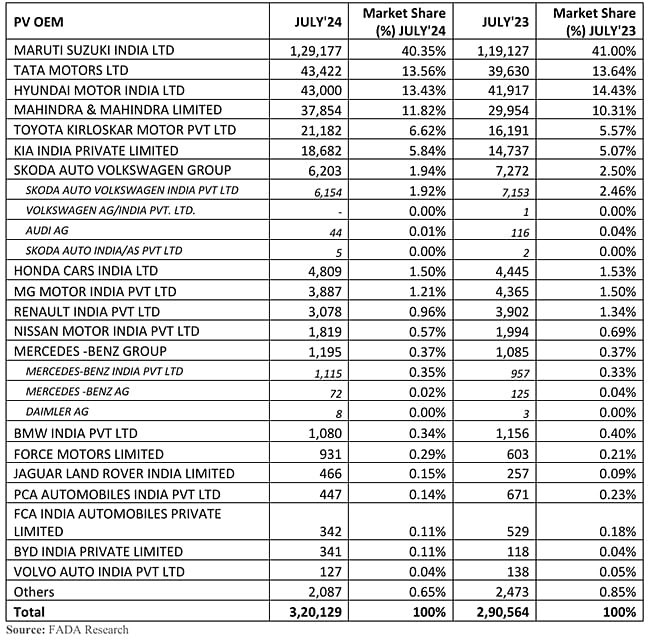
COMMERCIAL VEHICLES: 80,057 units, up 6% YoY, 10% MoM
Tata Motors remains the CV boss but M&M and Ashok Leyland see their market share rise
Commenting on the commercial vehicle sector’s retail performance in July (80,057 units), FADA vice-president C S Vigneshwar said: “Retail sales showed a 6% YoY growth, with dealers reporting mixed sentiments. Positive factors included growth in the construction and mining sectors, while challenges such as continuous rainfall, negative rural market sentiment, poor finance availability, and high vehicle prices were also noted. Some dealers achieved growth through small bulk deals and leveraging increased market reach and product acceptability.”
Though Tata Motors remains the boss of the sector with a 34% market share (27,492 units in July 2024), there is rising competition from Mahindra & Mahindra as well as Ashok Leyland, across different CV segments. M&M, which rules the pickup market with its Bolero brand, sold a total of 19,023 CVs for a 23.76% share, while Ashok Leyland saw its CV share rise to 17.38% from 16.3*=8% a year ago. VE Commercial Vehicles, with 6,607 units, sees its share increase to 8.25% from 7.30% a year ago.
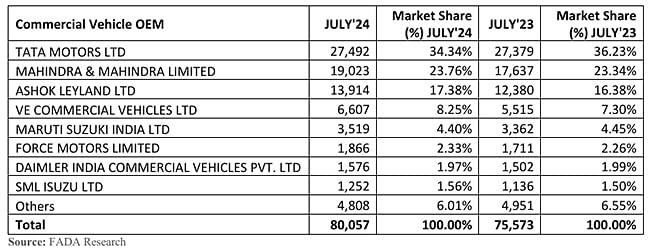 TRACTORS: 79,970 units, down 12% YoY, up 12.59% MoM
TRACTORS: 79,970 units, down 12% YoY, up 12.59% MoM
Mahindra tractor firms lead with market share of 43 percent
The tractor market has significantly underperformed in July 2024. Though the 79,970 units are 12.59% higher than June 2024’s 71,029 units, they remain 10,851 units below July 2023’s 90,821 units. This can be attributed to the trying weather conditions across different parts of the country last month which impacted farming and agricultural activity, something which could persist in August as well as September due to the La Nina weather phenomenon.
Though market leader Mahindra Group (Mahindra Tractors and Swaraj Tractors) sold 34,687 units in July 2024, this number is 2,610 units less than the 37,297 tractors retailed in July 2023. Nevertheless, M&M’s tractor market share is at 43% compared to 41% in July 2023.
International Tractors, which sold 11,141 units in July – 78 more than in July 2023 – increased its market share to 10.35% from 9.40% a year ago.
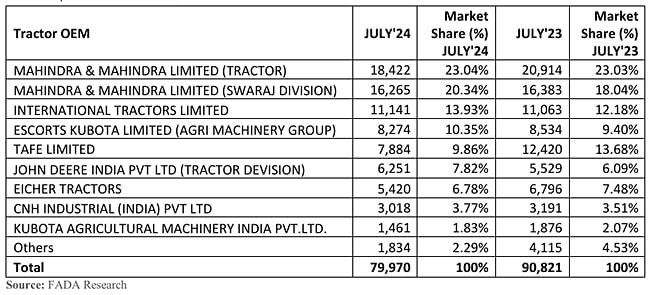
NEAR-TERM OUTLOOK: optimistic for two-wheelers, mixed bag for PVs and CVs
FADA’s near-term outlook for India Auto Inc’s retail segments is a blend of optimism and caution. While scooter and bike sales are expected to be buoyed by factors such as a growing rural economy, positive monsoon impact, introduction of new products and upcoming festive season, heavy rainfall, ongoing agricultural activities and inconsistent monsoon patterns may dampen demand in certain areas.
The passenger vehicle market could see mixed results, as per FADA. While the festive season, attractive schemes and good monsoon are expected to boost sales, concerns over low consumer sentiment, heavy rainfall and a lack of new product launches persist. High inventory levels pose a significant risk – FADA states that “it is crucial for PV OEMs to avoid further increases in stock to prevent financial strain on dealers.”
The CV sector has a positive outlook for the near-term including improved market reach and the festive season, tempered by challenges such as bad freight rates and ongoing rainfall.
All in all, the overall outlook is cautiously optimistic albeit the spoiler could just turn out to be the monsoon. The Indian Meteorological Department (IMD) has predicted that rainfall in August-September is likely to be 'above normal' due to the potential formation of La Nina conditions. While August may see a brief break in the monsoon, overall rainfall for the two months is expected to remain high, which is crucial for Kharif sowing and standing crops. However, excessive rains could lead to city flooding, floods in low-lying areas and landslides in hilly regions, potentially impacting auto retail sales.
ALSO READ: EV sales in India jump 53% in July to 179,000 units
Electric two-wheeler sales in July cross 100,000 units after four months
Electric 3Ws clock best-ever monthly sales in July: over 63,000 units
Electric car & SUV OEMs sell 7,500 units in July, 56,000 EVs in first 7 months of 2024
RELATED ARTICLES
Mahindra BE 6, XEV 9e sales cross 19,000 in H1 2025, EV retail market share rises to 17%
Between January and June, Mahindra & Mahindra has produced 19,915 units of its two electric-origin SUVs from the Chakan ...
EV sales in India race past a million units in first-half CY2025
Riding on strong double-digit growth in the 2-, 3-wheeler and passenger vehicle segments, India EV Inc sells 10,47,788 v...
Electric car and SUV sales jump 53% to 74,539 units in H1 2025, JSW MG and M&M grab 49% share
Following four straight months of 13,000-plus sales and best-ever monthly retails of 13,397 units in June, electric pass...





 05 Aug 2024
05 Aug 2024
 5879 Views
5879 Views





 Ajit Dalvi
Ajit Dalvi




